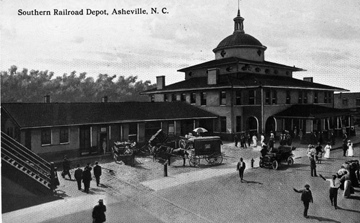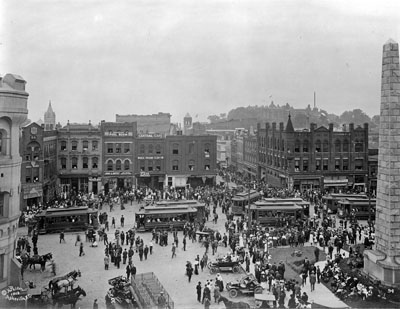See also: Biltmore House; Buncombe Turnpike; Grove Park Inn; Thomas Wolfe Memorial; University of North Carolina at Asheville; Asheville

Asheville, located in Buncombe County in western North Carolina, is situated on a plateau with an average altitude of 2,216 feet and guarded from severe temperature extremes by staggered mountain chains. The city was settled soon after the American Revolution at a crossroads of trails and on hunting grounds along the French Broad River seized from the Cherokee Indians. While still a frontier outpost, it was incorporated in 1797 and named for North Carolina governor Samuel Ashe (1795-98). In 1792 Buncombe County had been created as an entity so vast that it was called the "State of Buncombe." Asheville was selected as the site for a courthouse and has remained the county seat ever since. Asheville began to be opened up to the outside world when the Buncombe Turnpike came to town in 1827; three years later its population totaled 350. The Western Turnpike converged with the Buncombe Turnpike at Asheville in 1850, by which time the population had grown only to 520 people.
No strong secession sentiment stirred Asheville before the Civil War. Nonetheless, the Confederate government established a commissary, post office, and hospital there. In 1870, with a population of slightly more than 1,500, Asheville became an important mountain tobacco center and remained one until the late 1890s. It was, however, the coming of the Western North Carolina Railroad in 1880 that really gave Asheville a boost. The start of regular rail service ushered in a cycle of economic booms and busts.
Tourism, boosted by the region's renown as a haven for those seeking better health, became a major industry in Asheville beginning in the late nineteenth century. With the growth in tourism came an expansion of civic activities, public utilities, and educational and cultural facilities. An electric streetcar system that began operating in Asheville in 1887 was the second such system in the nation.

In the same year George Washington Vanderbilt commissioned architect Richard Morris Hunt and landscape architect Frederick Law Olmsted to create Biltmore House. The original estate covered 125,000 acres, and the mansion included 250 rooms. Completed in 1895, it was, at the time, one of the world's most technologically advanced houses as well as the largest private residence in the United States. After the completion of Biltmore House, many artisans stayed on in Asheville to work on other structures, and downtown Asheville boasts many noteworthy public and commercial buildings. Clayton native Douglas D. Ellington perhaps left the grandest mark, designing most of Asheville's Art Deco edifices, including the City Hall, the main building of the Lee Edwards High School, the S&W Cafeteria, and the First Baptist Church. Today, among U.S. cities, Asheville ranks second only to Miami Beach, Fla., in the number of surviving Art Deco buildings. Along with outstanding architecture there are several first-class hotels-including the famous Grove Park Inn-and historic sites-such as the Thomas Wolfe House-to remind visitors and townspeople alike of Asheville's rich history.
Tourism continues to account for about 25 percent of the Asheville metropolitan area's economy. Manufacturing, finance, government, health care, and education also provide significant numbers of jobs. Asheville is the home of several institutions of higher learning, most notably the University of North Carolina at Asheville. The Education, Arts, and Science Center is a downtown complex containing galleries, museums, performance spaces, and shops. In 2005, Asheville was North Carolina's tenth-largest city, with a population of more than 70,000. As of 2023, Asheville's population was 95,056, making it North Carolina's eleventh-largest city.